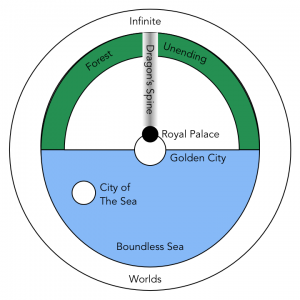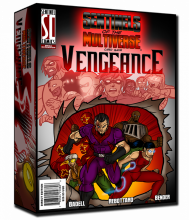(This is an Icon Set, for 13th Age, with obvious influences. )
The King has been gone for years, and the rumblings of court fear he may never return. For now, the Eternal Kingdom still stands, but enemies gather beyond the horizon, hoping for a sign of weakness. The King’s children, each a power to be reckoned with, jockey for position. Some hold strong to their bailiwicks within the Eternal Kingdom, others have taken the roads and ways to the infinite worlds beyond the horizon, in search of allies and power, or perhaps to withdraw from the conflict sure to come.
But whatever direction their struggles take them, the world still turns around them, and the thousand dangers and opportunities that underly the Eternal Kingdom churn on.
Adventuring in the Eternal Kingdom
The Icons of the Eternal Kingdom are its scions, the children of the king. Their infighting and struggles take place on a massive scale, yet are profoundly personal. While their infighting could be fuel for a game of its own, it also creates a backdrop for kicking down doors, killing dangerous monsters and other worthwhile pursuits.
One important difference between the Eternal Scions and other Icons is that much of what they do is secret – most NPCs of any note have a thread that connects them to one Icon or another, but even they may not be aware of it. Some of this is a function of their power – reality itself bends in subtle ways to comply to the will of the Icons – but it it also the nature of their conflicts. Open action invites retribution, so secret proxy fights are the norm.
This, of course, means that people like adventurers are of great use to the icons – effective enough to be useful, but still playing on a smaller chessboard than the Icons themselves (Arrogance is another common trait of the icons). Whether as a direct or indirect patron, the Icons are more than happy to work through adventurers to pursue their own ends, which are just as likely to be far-reaching and subtle as they are to be petty and vindictive..
While the icons may be engaging in their own internal struggles, there’s still a lot of be done. Monsters roam the wild places, with new threats walking in from the infinite worlds every day. Ancient ruins dot the mountains and forest. Mysterious islands fill the seas. Worlds of danger and treasure can be found in a wrong turn off a royal road, a misread map or an ancient and forgotten road.
For those of a more civilized bent, the many trading partners of the Golden City are all major urban hubs of their own, each of which would be the crown jewel of their world were they not in the shadow of the Golden City. These cities are in a constant struggle for prominence among themselves, and often within themselves as well. And, of course, there are dangers aplenty – no crossworld empire can exist with parasites and other dangers. While few of them may have the power to be a threat to the Icons, they still may have substantial power (and sinister agendas) within their own spheres, and their existence is almost certainly a benefit to somebody.
Icon Set: The Eternal Scions
The Scions of the King are beings of incredible power, though their appearance and motivations seem quite human. Superhumanly strong and durable and seemingly immortal, they are able to traverse the infinite worlds at will, finding treasures and raising armies with no more effort than you or I might take to go find a pair of shoes in our closet. They shape luck and circumstance to their will, and have thousands of years experience at their chosen pursuits. And those are only the abilities that everyone knows about.
However, they are also a family, albeit a profoundly dysfunctional one. They may come to blows, but it is rare that they do so with any permanent end in mind. Some of this is tradition – the king would not tolerate such things. Some is practicality – the death curse of a Scion is a terrible thing indeed. And some is probably sentiment – these are the people they’ve despised for millennia, and old enough hatreds can come close to a sort of affection.
 The General – Eldest son of the King by the golden queen, he has long since abandoned any claim in the throne in his pursuit of perfection on the battlefield (and with an understanding of how such ambitions lost him his siblings). He has no patience for the squabbles of his family, but at the same time, he figures heavily in all their plans, for none wish to make an enemy of him.
The General – Eldest son of the King by the golden queen, he has long since abandoned any claim in the throne in his pursuit of perfection on the battlefield (and with an understanding of how such ambitions lost him his siblings). He has no patience for the squabbles of his family, but at the same time, he figures heavily in all their plans, for none wish to make an enemy of him.
 The Regent – Second eldest son of the King by the sliver queen, he would be the perfect heir in every way save that of birth. Born before the marriage of his Mother and Father, his claim to the throne has always been tainted. Despite that he has made himself into a leader, and in the absence of the king, he has been been the administrator (and some say, de factor ruler) of the Eternal Kingdom. It’s common knowledge that the day will come that he seeks to make his claim openly.
The Regent – Second eldest son of the King by the sliver queen, he would be the perfect heir in every way save that of birth. Born before the marriage of his Mother and Father, his claim to the throne has always been tainted. Despite that he has made himself into a leader, and in the absence of the king, he has been been the administrator (and some say, de factor ruler) of the Eternal Kingdom. It’s common knowledge that the day will come that he seeks to make his claim openly.
 The Lost Prince – Younger Brother of the Regent and ever the Favorite of the King, he is much like his brother, save that in his legitimacy he has always held a place of primacy in their father’s eye. Or he did until he vanished somewhere in the infinite worlds, centuries ago. His body has never been found, and is is the hope or fear of many that he may someday return.
The Lost Prince – Younger Brother of the Regent and ever the Favorite of the King, he is much like his brother, save that in his legitimacy he has always held a place of primacy in their father’s eye. Or he did until he vanished somewhere in the infinite worlds, centuries ago. His body has never been found, and is is the hope or fear of many that he may someday return.
He is never far from the minds of the Kingdom, and whenever events take a strange turn, there will always be those who will take it as a sign of the Lost Prince’s actions, or a portent of his return.
 The Huntress – Last child of the silver queen, the ambitions of a daughter have been overshadowed by such brothers. But if their sun cast too much light, she has found refuge in the moon. Like her mother, she knows the secrets of the City of the Sky, and like her mother, she keeps them well.
The Huntress – Last child of the silver queen, the ambitions of a daughter have been overshadowed by such brothers. But if their sun cast too much light, she has found refuge in the moon. Like her mother, she knows the secrets of the City of the Sky, and like her mother, she keeps them well.
 The Sorceress – The eldest daughter of the bronze queen, she is a small dainty thing made of fire and razor blades. Her mother’s magic runs strong in her, and in a family of mighty warriors and dashing rogues, her wit and wisdom earn her words a seemingly disproportionate weight.
The Sorceress – The eldest daughter of the bronze queen, she is a small dainty thing made of fire and razor blades. Her mother’s magic runs strong in her, and in a family of mighty warriors and dashing rogues, her wit and wisdom earn her words a seemingly disproportionate weight.
 The Rake – A dashing figure of color and light, the son of the bronze queen is the very image of a hero. An accomplished swordsman, skilled sorcerer, able politician and all about man about town, he suffers only from the comparison of those around him. For every way in which he excels, someone in his family overshadows him.
The Rake – A dashing figure of color and light, the son of the bronze queen is the very image of a hero. An accomplished swordsman, skilled sorcerer, able politician and all about man about town, he suffers only from the comparison of those around him. For every way in which he excels, someone in his family overshadows him.
Still, his very obviousness makes him something of an Enigma – it is clear that he has ambitions and an agenda, but his overt actions are so blatant that most assume they are a smokescreen for something else.
 The Artist – Brilliant, mad or both, the artist is the youngest child of the bronze queen, he abandons and embraces mediums as readily as he creates and destroys work that lesser spirits would call masterpieces. At his best, he is a brilliant, dazzling soul that illuminates the whole kingdom. At his worse, he could very well crack the whole world open.
The Artist – Brilliant, mad or both, the artist is the youngest child of the bronze queen, he abandons and embraces mediums as readily as he creates and destroys work that lesser spirits would call masterpieces. At his best, he is a brilliant, dazzling soul that illuminates the whole kingdom. At his worse, he could very well crack the whole world open.
 The Watcher – A byblow of the king and a queen of the sea, she has remained apart from the workings of her family, more home beneath the waves, watching all through water and mirror. Her ambitions lie outside the Eternal Kingdom, but her secrets are valuable everywhere.
The Watcher – A byblow of the king and a queen of the sea, she has remained apart from the workings of her family, more home beneath the waves, watching all through water and mirror. Her ambitions lie outside the Eternal Kingdom, but her secrets are valuable everywhere.
 The Admiral – Eldest illegitimate child of the King and the iron queen, a bastard he was born and a bastard he has ever been. He stands out in a family of duplicitous backstabbers as a pirate and a rogue. While he does not wear his loyalties on his sleeve, he carries them on the edge of a knife.
The Admiral – Eldest illegitimate child of the King and the iron queen, a bastard he was born and a bastard he has ever been. He stands out in a family of duplicitous backstabbers as a pirate and a rogue. While he does not wear his loyalties on his sleeve, he carries them on the edge of a knife.
 The Warden – Second son of the iron queen, he is the keeper of the forests, hunter of dragons, the Warden in White, riding his mighty steed at the head of his pack of hounds. It is a duty he resents, far from the light and music of the court, but like all the children of iron, is is a duty he would lay down his life fulfilling.
The Warden – Second son of the iron queen, he is the keeper of the forests, hunter of dragons, the Warden in White, riding his mighty steed at the head of his pack of hounds. It is a duty he resents, far from the light and music of the court, but like all the children of iron, is is a duty he would lay down his life fulfilling.
 The Giant – Last son of the iron queen, he is taller and stronger than any in the family, and perhaps that size accounts for a heart that still beats with love and compassion within this den of vipers. A mighty combatant, he is no strategist or courtier, and while easily misdirected, he is a fearsome enemy indeed when riled.
The Giant – Last son of the iron queen, he is taller and stronger than any in the family, and perhaps that size accounts for a heart that still beats with love and compassion within this den of vipers. A mighty combatant, he is no strategist or courtier, and while easily misdirected, he is a fearsome enemy indeed when riled.
 The Romantic – Daughter of the king and a woman from the infinite worlds, the Romantic is the most beautiful woman in the Eternal Kingdom (though some few give that acclaim to the Huntress). She is well aware of her beauty, and many consider her little more than a vapid creature of the court, Indeed, she does not have the strength of arms or magic of her siblings, but she has chosen a different battlefield, trading swords for salons. Whether this is shallow attention seeking or a cunning agenda is something of an open question.
The Romantic – Daughter of the king and a woman from the infinite worlds, the Romantic is the most beautiful woman in the Eternal Kingdom (though some few give that acclaim to the Huntress). She is well aware of her beauty, and many consider her little more than a vapid creature of the court, Indeed, she does not have the strength of arms or magic of her siblings, but she has chosen a different battlefield, trading swords for salons. Whether this is shallow attention seeking or a cunning agenda is something of an open question.
 The Scoundrel – Youngest child of the king, he is the farthest from the throne and farthest from the considerations of it. He has abandoned ambition in favor of his own entertainments. An accomplished musician and a legendary gambler, there is very little the Scoundrel won’t do, except take on the responsibility that suits a prince.
The Scoundrel – Youngest child of the king, he is the farthest from the throne and farthest from the considerations of it. He has abandoned ambition in favor of his own entertainments. An accomplished musician and a legendary gambler, there is very little the Scoundrel won’t do, except take on the responsibility that suits a prince.
Relationships
- The Children of the iron queen (the Admiral, Warden and Giant) are a tightly knit cabal, and are well known for their loyalty to the Eternal Kingdom over politics. However, they are also known for their individual passions, which can overcome their better judgement.
- Similarly, the children of the bronze queen (Sorceress, Rake and Artist) form another cabal, more known for their cunning and general magical aptitude.
- The Children of the silver Queen were once a cabal as well, but something drove a spike between the Regent and the Lost Prince, and each pressured the Huntress to choose a side.
- Long ago, before any but the children of gold and silver can remember, there was a similar cabal among the children of gold. Terrifying as it is to contemplate today, the General was the least of his siblings. However, in their ambition, they became a threat to the King, and that spelled their doom and (presumed) death. It is said, among those who know, that the General’s aversion to politics is all that spared his life.
- The Warden is said to have an inappropriate affection for the Sorceress.
- The Artist and the Watcher were born at nearly the same time, with the Watcher a little bit older. This is uncommon in the family, and the two have a close bond as a result, with her viewing him as something of a little brother.
- The Regent and Admiral are said to be close friends, though given who they are, the question is which one is faking it.
- The Regent currently holds his power with the support of the Children of Iron and the lack of a strong opposition. In the absence of the Lost Prince, there are not many who could press a claim for rulership (perhaps the Rake). But at the same time, his position is more tenuous than it seems – the children of iron are traditionalists, and if the Regent overreaches, then he may find his position quickly crumbles.
The Eternal Kingdom

The Golden City – Crown jewel of the Eternal Kingdom, the Golden City is a true crossroad of worlds, sitting at the hub of trade routes that extend out into the infinite worlds. The whole city is wrapped around a great harbor, and proceeds uphill, overlooked by the Royal Palace.
- The Admiral and The Giant spend much of their time in the city, and are frequently seen in the harbor area.
- The Scoundrel tends to leave quite a trail in his wake when he’s in town.
- The Romantic is a fixture in the better parts of the city.
The Royal Palace – Seat of the king and home of the royal family, it is a masterpiece of architecture and magic, overlooking the Golden city, and by extension, the infinite worlds beyond it. The royal family makes their home there, and it is said that is is rife with their secret playthings and powers.
- Every Icon (save the Lost Prince) can be found in the Palace at one some time or another, though some are more frequent occupants.
- The Regent’s seat of power is the palace.
- When not in the city, The Romantic is almost certain to be found in the Palace
- The Sorceress makes heavy use of the Palace’s Library, and the Artist has an entire hall dedicated to his work.
The Dragon’s Spine The mountain that holds the Golden City and Royal Palace on its slopes is the southernmost peak of a mountain range that extends far to the north. As old as the golden city is, these mountains are older still, and outside of a few forts and outposts, it is still largely wild country, home to monsters and ancient ruins.
- The General takes the mountains more seriously than most of the rest of the family (Perhaps knowing something that he has not shared). He maintains an elite team of mountaineers who patrol the mountins to the best of their ability.
- The Peak of the eternal Mountain is the gateway to the City of the Sky, and as such, it is often frequented by the Huntress.
The Forest Unending – To leave the eternal kingdom by land, you will eventually pass through the forest. All roads pass through it, but the roads are only the smallest fraction of it vastness. Entire kingdoms exist within the forest, never seeing beyond its bounds. And, of course, the oldest and most dangerous creatures can be found in its shadowy depths.
- The forest is the Warden’s domain, this fact is uncontested. His army of rangers is the largest standing force in the Eternal Kingdom, but they are still spread incredibly thin.
- The Huntress is no stranger to the Forest, but her presence is not always welcomed by the Warden.
- The Sorceress also has some secrets in the Forest, and some whisper that she is the leader of a cabal of witches whose influence extends far and wide.
The Boundless Sea – While less obvious than the roads through the Forest Unending, the seas around the Eternal Kingdom are full of ways out into the infinite worlds. The barriers between worlds are rarely obvious, and the result is a vast and shifting sea, full of monsters, mysterious islands and, of course, pirates. The navies of the Eternal Kingdom and her allies keep the trade routes as safe as they can, but there are always new dangers emerging.
- The Admiral and the Giant lead the Eternal Kingdom’s Northern and Southern Fleet, They spend much of their time at sea.
- The Watcher’s interest in the City of the Waves keeps her interested in affairs upon the Boundless Sea.
- The bronze queen came from an island to the south, and the Sorceress, Rake and Artist all spend some time in transit to and from her homeland.
The City of the Waves – Beneath the sea, not far from the coast of the Golden City, stands the Golden City’s sister city. Ancient magic renders the waters around the city breathable, though the natives no longer need such magics. The city’s population is small, but it holds many secrets and unknown magics, and superstition suggests that any disruption in one city will be reflected in the other. Whether true or not, this concern has allowed the two cities a peaceful coexistence without the tensions one might expect of two powers in such close proximity.
- The Watcher makes her home in the City of the Waves, and while she is not the Queen, her influence is extensive. More, she is also privy to many of the City’s secrets.
- The Scoundrel has cut an impressive trail through the City, and there is a death sentence waiting for him should he ver return, though the details of why this is so are fuzzy.
- The silver queen had close ties to the City of the Waves, and her children are welcome there. The regent rarely has time to visit and the Lost Prince is missed, but The Huntress is a regular visitor.
- The Romantic visits often enough to maintain relations with the city’s elite.
- The Admiral and Giant have a tense relationship with the City. The people of the Sea are nominally allies to the fleets, but it is usually on their terms.
The City of the Sky – When the moon is full, a ghostly reflection of the golden city appears in the sky above the golden city itself. A silvery staircase rises from the peak of the royal mountain, and the brave (or mad) can travel up those stairs to face the visions that await them and try to return before the city vanishes again. Those who survive the trip report visions of the past and future, and many feel the secrets to be learned are worth the risk
- It is rare that a full moon comes around and the Huntress does not visit the ghostly city. Given the risk of a stray cloud, it may be safe to assume she knows something the others do not.
- Some suspect that the Lost Prince is trapped in the city in the Sky, and that the Huntress’s journeys are in search of her brother.
The Infinite Worlds – Beyond the bounds of the Eternal Kingdom are an infinite number of worlds and realities. It is said that the royal family can travel freely among them, but everyone else depends upon the roads and sea lanes laid down by the King and maintained by his children. Worlds of every type exist, but the lanes lead only to ones that are of some use to the Eternal Kingdom, but the worlds the lanes pass through can be less predictable.
- The Scoundrel and General spend much of their time among the worlds, both looking to avoid the Eternal Kingdom (though neither would appreciate the comparison).
- Every few decades, the Romantic finds a world that appeals to her sensibilities. She will spend time cultivating artists, philosophers and intellectuals, and eventually she will return to the Eternal Kingdom with the seeds of the latest fashions.
- It is suspected that the Lost Prince is lost somewhere among the Infinite Worlds, though it difficult to say what could keep him lost against his will.
Mechanical Notes
- For dice rolling purposes, The Lost Prince serves as the spoiler. In circumstances of unknown and uncertainty, things are often attributed to the Lost Prince.
- None of the icons are particularly good or evil, so by default, they are all priced as ambiguous. If it is critical for your game to have Heroic and Villainous Icons, then you may assign them as you see fit, but I would lean towards The General, The Lost Prince and the Giant as Heroic, and the Sorceress, Artist and Admiral as Villainous.
- A player may choose one or more of their personal Icons to be a secret to them, in which case the GM is free to decide who it is at any point down the line. There is no particular mechanical advantage to this, but sometimes it’s just fun.
Sorcery in the Eternal Kingdom
Sorcerers do not draw their power directly from the Icons, but rather are indebted to an icon for their power. The Icons hold many secret sources of power – Founts of flame, bottled lighting and so on – which they share with those they favor (or which may be stolen). As such, Sorcerous Backgrounds are replaced with Sorcerous Secrets. These secrets are rarely tied to a single Scion, rather, some scions are inclined towards certain secrets.
The Eternal Kingdom equivalents of 13th age Sorcerous backgrounds follow:
- Arcane Heritage becomes Secrets of the Sun and is tied to the southern isle and the traditions of the bronze queen. It may be tied any one of the children of bronze (Sorceress, Rake or Artist).
- Chromatic Destroyer becomes Secret of the Storms – The character has attuned to the four great storms (Ice, lightning, poison and acid) beyond the bounds of the Eternal Kingdom. Finding the storms is difficulty enough, and surviving them is something else entirely, but if survived, they are a potent source of power. Any scion could show someone the way to this power, if they had sufficient incentive.
- Fey Heritage becomes Secrets of the Sea and is the domain of the Watcher
- Infernal Heritage becomes Secrets of the Sword. In a hidden chamber, somewhere in the vicinity of where the Dragon’s Spine meets the Forest Unending lies the tomb of a would be conquerer. The figure of a giant of a man (easily 12 feet tall) lies in state, clad in black armor and impaled by a great red sword. None have successfully drawn the sword free, but those who have tried carry away a bit of its power. The General knows where this chamber is, as does the Warden. The Sorceress and the Regent may also know. It’s possible that other Scions know, but it’s a well-kept secret.
- Metallic Protector Heritage becomes Secrets of the Sky – These can only be learned in the City of the Sky, so the Huntress is the most obvious avenue to this power.
- Undead Remnant Heritage becomes Secrets of Shadow. These are the vestiges of an enemy of The Eternal Kingdom, long since vanquished, but with necromantic relics still scattered through the Infinite Worlds. The Scions largely destroy these relics when they find them, but some are kept in back pockets when needed. Of course, some suspect that the use of the power of those relics may suggest that the enemy is not quite so vanquished as all that.
References
 I’m intermittently working on a terrible idea of a game, a fantasy heartbreaker which I’ve currently title “NMMDI” or “Nyquil Made Me Do It”. This is the actual working title, on the cover, in Papyrus. I have no better way to insure it gets a real name if I ever finish it.
I’m intermittently working on a terrible idea of a game, a fantasy heartbreaker which I’ve currently title “NMMDI” or “Nyquil Made Me Do It”. This is the actual working title, on the cover, in Papyrus. I have no better way to insure it gets a real name if I ever finish it.














